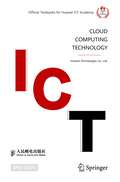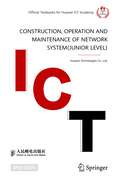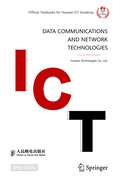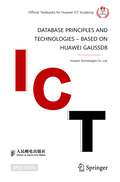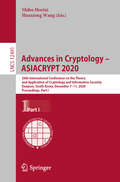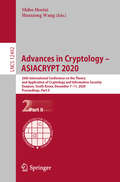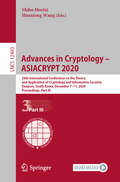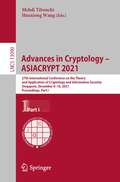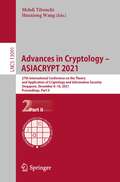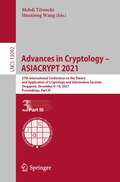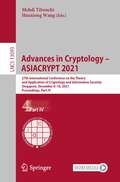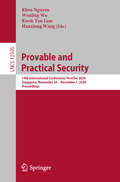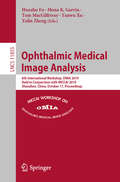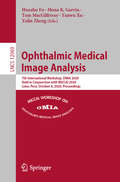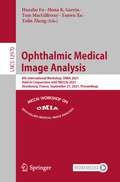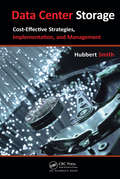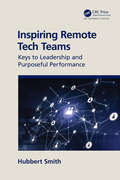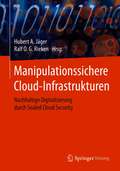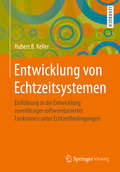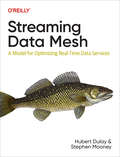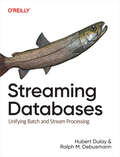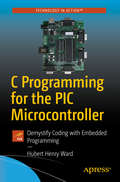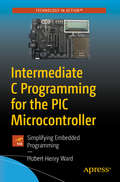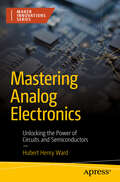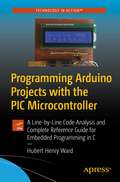- Table View
- List View
Cloud Computing Technology
by Huawei Technologies Co., Ltd.This open access book introduces cloud computing and related technologies from the concept, technology, and architecture of cloud computing, combined with typical application cases of cloud; provides students with a more complete knowledge framework in the field of cloud computing; and lays the foundation for future research, development, and further study in cloud computing, big data, and other related fields. As the world's leading provider of ICT (information and communication technology) infrastructure and intelligence terminals, Huawei's products are already available in a number of areas, including connectivity, security, wireless, storage, cloud computing, intelligent computing, and artificial intelligence.
Construction, Operation and Maintenance of Network System(Junior Level)
by Huawei Technologies Co., Ltd.This open access book follows the development rules of network technical talents, simultaneously placing its focus on the transfer of network knowledge, the accumulation of network skills, and the improvement of professionalism. Through the complete process from the elaboration of the theories of network technology to the analysis of application scenarios then to the design and implementation of case projects, readers are enabled to accumulate project experience and eventually acquire knowledge and cultivate their ability so as to lay a solid foundation for adapting to their future positions. This book comprises six chapters, which include “General Operation Safety of Network System,” “Cabling Project,” “Hardware Installation of Network System,” “Basic Knowledge of Network System,” “Basic Operation of Network System,” and “Basic Operation and Maintenance of Network System.” This book can be used for teaching and training for the vocational skills certification of network system construction, operation, and maintenance in the pilot work of Huawei’s “1+X” Certification System, and it is also suitable as a textbook for application-oriented universities, vocational colleges, and technical colleges. In the meantime, it can also serve as a reference book for technicians engaged in network technology development, network management and maintenance, and network system integration. As the world’s leading ICT (information and communications technology) infrastructure and intelligent terminal provider, Huawei Technologies Co., Ltd. has covered many fields such as data communication, security, wireless, storage, cloud computing, intelligent computing, and artificial intelligence. Taking Huawei network equipment (routers, switches, wireless controllers, and wireless access points) as the platform, and based on network engineering projects, this book organizes all the contents according to the actual needs of the industry.
Data Communications and Network Technologies
by Huawei Technologies Co., Ltd.This open access book is written according to the examination outline for Huawei HCIA-Routing Switching V2.5 certification, aiming to help readers master the basics of network communications and use Huawei network devices to set up enterprise LANs and WANs, wired networks, and wireless networks, ensure network security for enterprises, and grasp cutting-edge computer network technologies. The content of this book includes: network communication fundamentals, TCP/IP protocol, Huawei VRP operating system, IP addresses and subnetting, static and dynamic routing, Ethernet networking technology, ACL and AAA, network address translation, DHCP server, WLAN, IPv6, WAN PPP and PPPoE protocol, typical networking architecture and design cases of campus networks, SNMP protocol used by network management, operation and maintenance, network time protocol NTP, SND and NFV, programming, and automation. As the world’s leading provider of ICT (information and communication technology) infrastructure and smart terminals, Huawei’s products range from digital data communication, cyber security, wireless technology, data storage, cloud-computing, and smart computing to artificial intelligence.
Database Principles and Technologies – Based on Huawei GaussDB
by Huawei Technologies Co., Ltd.This open access book contains eight chapters that deal with database technologies, including the development history of database, database fundamentals, introduction to SQL syntax, classification of SQL syntax, database security fundamentals, database development environment, database design fundamentals, and the application of Huawei’s cloud database product GaussDB database. This book can be used as a textbook for database courses in colleges and universities, and is also suitable as a reference book for the HCIA-GaussDB V1.5 certification examination. The Huawei GaussDB (for MySQL) used in the book is a Huawei cloud-based high-performance, highly applicable relational database that fully supports the syntax and functionality of the open source database MySQL. All the experiments in this book can be run on this database platform. As the world’s leading provider of ICT (information and communication technology) infrastructure and smart terminals, Huawei’s products range from digital data communication, cyber security, wireless technology, data storage, cloud computing, and smart computing to artificial intelligence.
Advances in Cryptology – ASIACRYPT 2020: 26th International Conference on the Theory and Application of Cryptology and Information Security, Daejeon, South Korea, December 7–11, 2020, Proceedings, Part I (Lecture Notes in Computer Science #12491)
by Shiho Moriai Huaxiong WangThe three-volume proceedings LNCS 12491, 12492, and 12493 constitutes the proceedings of the 26th International Conference on the Theory and Application of Cryptology and Information Security, ASIACRYPT 2020, which was held during December 7-11, 2020. The conference was planned to take place in Daejeon, South Korea, but changed to an online format due to the COVID-19 pandemic.The total of 85 full papers presented in these proceedings was carefully reviewed and selected from 316 submissions. The papers were organized in topical sections as follows: Part I: Best paper awards; encryption schemes.- post-quantum cryptography; cryptanalysis; symmetric key cryptography; message authentication codes; side-channel analysis. Part II: public key cryptography; lattice-based cryptography; isogeny-based cryptography; quantum algorithms; authenticated key exchange. Part III: multi-party computation; secret sharing; attribute-based encryption; updatable encryption; zero knowledge; blockchains and contact tracing.
Advances in Cryptology – ASIACRYPT 2020: 26th International Conference on the Theory and Application of Cryptology and Information Security, Daejeon, South Korea, December 7–11, 2020, Proceedings, Part II (Lecture Notes in Computer Science #12492)
by Shiho Moriai Huaxiong WangThe three-volume proceedings LNCS 12491, 12492, and 12493 constitutes the proceedings of the 26th International Conference on the Theory and Application of Cryptology and Information Security, ASIACRYPT 2020, which was held during December 7-11, 2020. The conference was planned to take place in Daejeon, South Korea, but changed to an online format due to the COVID-19 pandemic.The total of 85 full papers presented in these proceedings was carefully reviewed and selected from 316 submissions. The papers were organized in topical sections as follows: Part I: Best paper awards; encryption schemes.- post-quantum cryptography; cryptanalysis; symmetric key cryptography; message authentication codes; side-channel analysis. Part II: public key cryptography; lattice-based cryptography; isogeny-based cryptography; quantum algorithms; authenticated key exchange. Part III: multi-party computation; secret sharing; attribute-based encryption; updatable encryption; zero knowledge; blockchains and contact tracing.
Advances in Cryptology – ASIACRYPT 2020: 26th International Conference on the Theory and Application of Cryptology and Information Security, Daejeon, South Korea, December 7–11, 2020, Proceedings, Part III (Lecture Notes in Computer Science #12493)
by Shiho Moriai Huaxiong WangThe three-volume proceedings LNCS 12491, 12492, and 12493 constitutes the proceedings of the 26th International Conference on the Theory and Application of Cryptology and Information Security, ASIACRYPT 2020, which was held during December 7-11, 2020. The conference was planned to take place in Daejeon, South Korea, but changed to an online format due to the COVID-19 pandemic.The total of 85 full papers presented in these proceedings was carefully reviewed and selected from 316 submissions. The papers were organized in topical sections as follows: Part I: Best paper awards; encryption schemes.- post-quantum cryptography; cryptanalysis; symmetric key cryptography; message authentication codes; side-channel analysis. Part II: public key cryptography; lattice-based cryptography; isogeny-based cryptography; quantum algorithms; authenticated key exchange. Part III: multi-party computation; secret sharing; attribute-based encryption; updatable encryption; zero knowledge; blockchains and contact tracing.
Advances in Cryptology – ASIACRYPT 2021: 27th International Conference on the Theory and Application of Cryptology and Information Security, Singapore, December 6–10, 2021, Proceedings, Part I (Lecture Notes in Computer Science #13090)
by Huaxiong Wang Mehdi TibouchiThe four-volume proceedings LNCS 13090, 13091, 13092, and 13093 constitutes the proceedings of the 27th International Conference on the Theory and Application of Cryptology and Information Security, ASIACRYPT 2021, which was held during December 6-10, 2021. The conference was planned to take place in Singapore, but changed to an online format due to the COVID-19 pandemic. The total of 95 full papers presented in these proceedings was carefully reviewed and selected from 341 submissions. The papers were organized in topical sections as follows: Part I: Best paper awards; public-key cryptanalysis; symmetric key cryptoanalysis; quantum security; Part II: physical attacks, leakage and countermeasures; multiparty computation; enhanced public-key encryption and time-lock puzzles; real-world protocols; Part III: NIZK and SNARKs; theory; symmetric-key constructions; homomorphic encryption and encrypted search; Part IV: Lattice cryptanalysis; post-quantum cryptography; advanced encryption and signatures; zero-knowledge proofs, threshold and multi-signatures; authenticated key exchange.
Advances in Cryptology – ASIACRYPT 2021: 27th International Conference on the Theory and Application of Cryptology and Information Security, Singapore, December 6–10, 2021, Proceedings, Part II (Lecture Notes in Computer Science #13091)
by Huaxiong Wang Mehdi TibouchiThe four-volume proceedings LNCS 13090, 13091, 13092, and 13093 constitutes the proceedings of the 27th International Conference on the Theory and Application of Cryptology and Information Security, ASIACRYPT 2021, which was held during December 6-10, 2021. The conference was planned to take place in Singapore, but changed to an online format due to the COVID-19 pandemic. The total of 95 full papers presented in these proceedings was carefully reviewed and selected from 341 submissions. The papers were organized in topical sections as follows: Part I: Best paper awards; public-key cryptanalysis; symmetric key cryptanalysis; quantum security; Part II: physical attacks, leakage and countermeasures; multiparty computation; enhanced public-key encryption and time-lock puzzles; real-world protocols; Part III: NIZK and SNARKs; theory; symmetric-key constructions; homomorphic encryption and encrypted search; Part IV: Lattice cryptanalysis; post-quantum cryptography; advanced encryption and signatures; zero-knowledge proofs, threshold and multi-signatures; authenticated key exchange.
Advances in Cryptology – ASIACRYPT 2021: 27th International Conference on the Theory and Application of Cryptology and Information Security, Singapore, December 6–10, 2021, Proceedings, Part III (Lecture Notes in Computer Science #13092)
by Huaxiong Wang Mehdi TibouchiThe four-volume proceedings LNCS 13090, 13091, 13092, and 13093 constitutes the proceedings of the 27th International Conference on the Theory and Application of Cryptology and Information Security, ASIACRYPT 2021, which was held during December 6-10, 2021. The conference was planned to take place in Singapore, but changed to an online format due to the COVID-19 pandemic. The total of 95 full papers presented in these proceedings was carefully reviewed and selected from 341 submissions. The papers were organized in topical sections as follows: Part I: Best paper awards; public-key cryptanalysis; symmetric key cryptanalysis; quantum security; Part II: physical attacks, leakage and countermeasures; multiparty computation; enhanced public-key encryption and time-lock puzzles; real-world protocols; Part III: NIZK and SNARKs; theory; symmetric-key constructions; homomorphic encryption and encrypted search; Part IV: Lattice cryptanalysis; post-quantum cryptography; advanced encryption and signatures; zero-knowledge proofs, threshold and multi-signatures; authenticated key exchange.
Advances in Cryptology – ASIACRYPT 2021: 27th International Conference on the Theory and Application of Cryptology and Information Security, Singapore, December 6–10, 2021, Proceedings, Part IV (Lecture Notes in Computer Science #13093)
by Huaxiong Wang Mehdi TibouchiThe four-volume proceedings LNCS 13090, 13091, 13092, and 13093 constitutes the proceedings of the 27th International Conference on the Theory and Application of Cryptology and Information Security, ASIACRYPT 2021, which was held during December 6-10, 2021. The conference was planned to take place in Singapore, but changed to an online format due to the COVID-19 pandemic. The total of 95 full papers presented in these proceedings was carefully reviewed and selected from 341 submissions. The papers were organized in topical sections as follows: Part I: Best paper awards; public-key cryptanalysis; symmetric key cryptanalysis; quantum security; Part II: physical attacks, leakage and countermeasures; multiparty computation; enhanced public-key encryption and time-lock puzzles; real-world protocols; Part III: NIZK and SNARKs; theory; symmetric-key constructions; homomorphic encryption and encrypted search; Part IV: Lattice cryptanalysis; post-quantum cryptography; advanced encryption and signatures; zero-knowledge proofs, threshold and multi-signatures; authenticated key exchange.
Provable and Practical Security: 14th International Conference, ProvSec 2020, Singapore, November 29 – December 1, 2020, Proceedings (Lecture Notes in Computer Science #12505)
by Khoa Nguyen Wenling Wu Kwok Yan Lam Huaxiong WangThis book constitutes the refereed proceedings of the 14th International Conference on Provable Security, ProvSec 2020, held in Singapore, in November 2020. The 20 full papers presented were carefully reviewed and selected from 59 submissions. The papers focus on provable security as an essential tool for analyzing security of modern cryptographic primitives. They are divided in the following topical sections: signature schemes, encryption schemes and NIZKS, secure machine learning and multiparty computation, secret sharing schemes, and security analyses.* The conference was held virtually due to the COVID-19 pandemic.
Ophthalmic Medical Image Analysis: 6th International Workshop, OMIA 2019, Held in Conjunction with MICCAI 2019, Shenzhen, China, October 17, Proceedings (Lecture Notes in Computer Science #11855)
by Yanwu Xu Mona K. Garvin Huazhu Fu Tom MacGillivray Yalin ZhengThis book constitutes the refereed proceedings of the 6th International Workshop on Ophthalmic Medical Image Analysis, OMIA 2019, held in conjunction with the 22nd International Conference on Medical Imaging and Computer-Assisted Intervention, MICCAI 2019, in Shenzhen, China, in October 2019. The 22 full papers (out of 36 submissions) presented at OMIA 2019 were carefully reviewed and selected. The papers cover various topics in the field of ophthalmic image analysis.
Ophthalmic Medical Image Analysis: 7th International Workshop, OMIA 2020, Held in Conjunction with MICCAI 2020, Lima, Peru, October 8, 2020, Proceedings (Lecture Notes in Computer Science #12069)
by Yanwu Xu Mona K. Garvin Huazhu Fu Tom MacGillivray Yalin ZhengThis book constitutes the refereed proceedings of the 6th International Workshop on Ophthalmic Medical Image Analysis, OMIA 2020, held in conjunction with the 23rd International Conference on Medical Imaging and Computer-Assisted Intervention, MICCAI 2020, in Lima, Peru, in October 2020. The workshop was held virtually due to the COVID-19 crisis.The 21 papers presented at OMIA 2020 were carefully reviewed and selected from 34 submissions. The papers cover various topics in the field of ophthalmic medical image analysis and challenges in terms of reliability and validation, number and type of conditions considered, multi-modal analysis (e.g., fundus, optical coherence tomography, scanning laser ophthalmoscopy), novel imaging technologies, and the effective transfer of advanced computer vision and machine learning technologies.
Ophthalmic Medical Image Analysis: 8th International Workshop, OMIA 2021, Held in Conjunction with MICCAI 2021, Strasbourg, France, September 27, 2021, Proceedings (Lecture Notes in Computer Science #12970)
by Yanwu Xu Mona K. Garvin Huazhu Fu Tom MacGillivray Yalin ZhengThis book constitutes the refereed proceedings of the 8th International Workshop on Ophthalmic Medical Image Analysis, OMIA 2021, held in conjunction with the 24th International Conference on Medical Imaging and Computer-Assisted Intervention, MICCAI 2021, in Strasbourg, France, in September 2021.* The 20 papers presented at OMIA 2021 were carefully reviewed and selected from 31 submissions. The papers cover various topics in the field of ophthalmic medical image analysis and challenges in terms of reliability and validation, number and type of conditions considered, multi-modal analysis (e.g., fundus, optical coherence tomography, scanning laser ophthalmoscopy), novel imaging technologies, and the effective transfer of advanced computer vision and machine learning technologies. *The workshop was held virtually.
Data Center Storage: Cost-Effective Strategies, Implementation, and Management
by Hubbert SmithWe overspend on data center storage ... yet, we fall short of business requirements. It's not about the technologies. It's about the proper application of technologies to deliver storage services efficiently and affordably. It's about meeting business requirements dependent on data center storage. Spend less, deliver more. Data Center Storage: Cost-Effective Strategies, Implementation, and Management provides an industry insider's insight on how to properly scope, plan, evaluate, and implement storage technologies to maximize performance, capacity, reliability, and power savings. It provides business and use-case focused coverage of storage technology, including storage area networks (SAN), capacity-optimized drives, and solid-state drives. It offers key insights on financially responsible spending for data center storage. Delivered in accessible language, the book starts with a discussion of the business merits of replacing direct attached, compartmentalized storage with consolidated SAN-attached storage. The author advises on the use of service level applications (SLAs) as a tool to drive business unit collaboration with IT and prioritize those actions that impact productivity and profit from those that are less critical. This business guide to applied technologies disassembles big problems into digestible segments to help you understand, quantify, and fix any problems that arise as you work towards meeting your growing storage needs. The book builds on the consolidation and SLA driven approach to take advantage of the compelling benefits and potential savings of managed hosting and cloud storage.
Inspiring Remote Tech Teams: Keys to Leadership and Purposeful Performance
by Hubbert SmithFor me and other tech people, leaders, and members of remote teams, we will be awakened by all the fantastic hands-on hints, best practices, and guiding principles based on solid ground that Hubbert provides in Inspiring Remote Tech Teams. We will be better prepared and better equipped to both contribute and lead efficiently in the digital economies that shape the future of our world. — Thomas DiGiacomo, President of Engineering and Innovation at SUSE Inspiring Remote Tech Teams is a trail map to building effective teams and organizations—now, as world health dictates remote work, and in the future, as global talent pools contribute to our digital economy. Humans are wired to be social, and world events require social distancing from our office community. The absence of "community" triggers primitive brain responses. These instinctual responses of survival, social belonging, and the power of story all profoundly surface during our reaction as we adjust to remote work. This trail map for team leaders improves team execution despite physical separation. The book covers simple neuroscience as it applies to our "separation." It is a hands-on guide to maintaining and improving teamwork while working remotely. It is also a hands-on guide at the intersection of teams + remote + laymen’s neuroscience to create a positive sense of enthusiasm, engagement, and contribution, even when working apart. Remote teams, now and for the future, are the pathway to using global talent effectively. This book examines the combination of the "hard skills" of tech team project management and the "soft skills" of healthy distributed teams: remote offices, sales offices, partners, suppliers, customers, and teams engaging global talent pools. Practical examples and best practices offer hands-on methods to use neuroscience to help teams be their best, to improve collaboration, and to deliver consistent team results.
Manipulationssichere Cloud-Infrastrukturen: Nachhaltige Digitalisierung durch Sealed Cloud Security
by Hubert A. Jäger Ralf O. G. RiekenIm Rahmen der sich beschleunigenden Digitalisierung wandern sowohl in der Privatwirtschaft als auch den öffentlichen Verwaltungen viele als kritisch bewertete Anwendungen und Dienste in die Cloud. Big Data, Maschinelles Lernen und Künstliche Intelligenz bieten viele Vorteile, werfen aber wachsende Sicherheits- und Datenschutzprobleme auf. Die Sicherheit der informationstechnischen Systeme, einschließlich und insbesondere der Cloud, wird somit zum Dreh- und Angelpunkt einer zuverlässigen, nachhaltigen und sicheren Wirtschaft und Verwaltung.Das vorliegende Buch gibt Antworten auf die von Sicherheitsverantwortlichen und -forschern gleichermaßen gestellte Frage „Wieviel Sicherheit ist genug?“. Dabei werden der rechtliche Rahmen beleuchtet, das Vertrauensdilemma des Cloud Computing herausgearbeitet und die grundsätzlich zur Verfügung stehenden Optionen für Cloud-Sicherheit mit einer Modellierung der Erfolgswahrscheinlichkeit der Angreifer beschrieben und quantitativ analysiert. Es wird gezeigt, wie mit dem Konzept einer manipulationssicheren, versiegelten Verarbeitung der notwendige Durchbruch bezüglich Datenschutz und IT-Sicherheit erzielt werden kann.Mit verschiedenen praktischen Anwendungsfällen der Sealed-Cloud-Technologie wird gezeigt, wie mit solch europäisch implementiertem „Confidential Cloud Computing“ Souveränität in der Datenökonomie gewonnen werden kann.
Entwicklung von Echtzeitsystemen: Einführung in die Entwicklung zuverlässiger softwarebasierter Funktionen unter Echtzeitbedingungen
by Hubert B. KellerEin hilfreicher Wegweiser zur Entwicklung von Echtzeitsystemen Dieses Buch führt Sie umfassend in die Entwicklung zuverlässiger softwarebasierter Echtzeitsysteme ein. Dazu beleuchtet der Autor Hubert B. Keller alle Entwicklungsaspekte dieser Systeme, nämlich:· Die wichtige Rolle von Automatisierungssoftware· Software-Engineering· Safety- und Security-Aspekte· Scheduling· Implementierung Eignen Sie sich mit diesem Werk konstruktive Ansätze an und erfahren Sie, welche Anforderungen eine erfolgreiche Implementierung an Realzeitsysteme in der Automatisierung stellt. Zudem erhalten Sie mit diesem Buch eine konkrete Anleitung zu einer inkrementellen Vorgehensweise, um mögliche Fehler, Kosten und Risiken bei der Entwicklung von Echtzeitsystemen zu minimieren.Die integrative Darstellung und Bewertung der notwendigen Randbedingungen und die Methoden zur Realisierung von softwarebasierten Funktionen unter Echtzeitbedingungen machen dieses Buch zu einer wertvollen Ergänzung in der Berufspraxis. So konzipieren und entwickeln Sie zuverlässige SystemeZu Beginn erläutert der Autor die Grundlagen. Erfahren Sie in diesem Buch, welche Motivation hinter der Entwicklung von Echtzeitsystemen steht, wie der aktuelle Entwicklungsstand aussieht und welche Rolle Programmiersprachen und die Wertschöpfung durch Software in Unternehmen spielen. In den folgenden Kapiteln stehen u. a. diese weiterführenden Aspekte im Vordergrund:· Herstellungsprozesse für Software· Analyse und Bewertung von Konzepten zur Ereignisbehandlung unter Echtzeitbedingungen· Prozesskonzept und Scheduling als Basis für zuverlässige Echtzeitsysteme· Programmierung von Echtzeitsystemen mit hoher Zuverlässigkeit· Integrative Betrachtung von technischer Sicherheit und Informationssicherheit· Beispielhafte Umsetzung der Entwicklungsmethodik Abschließend gibt Ihnen der Autor konkrete Empfehlungen für die Entwicklung einer zuverlässigen Automatisierungssoftware. Zu empfehlen ist das Buch „Entwicklung von Echtzeitsystemen“ speziell für: a) Ingenieureb) Informatikerc) Entwickler Durch die behandelten Inhalte eignet sich das Buch sowohl für Studium als für das Selbststudium.
Streaming Data Mesh: A Model for Optimizing Real-Time Data Services
by Stephen Mooney Hubert DulayData lakes and warehouses have become increasingly fragile, costly, and difficult to maintain as data gets bigger and moves faster. Data meshes can help your organization decentralize data, giving ownership back to the engineers who produced it. This book provides a concise yet comprehensive overview of data mesh patterns for streaming and real-time data services.Authors Hubert Dulay and Stephen Mooney examine the vast differences between streaming and batch data meshes. Data engineers, architects, data product owners, and those in DevOps and MLOps roles will learn steps for implementing a streaming data mesh, from defining a data domain to building a good data product. Through the course of the book, you'll create a complete self-service data platform and devise a data governance system that enables your mesh to work seamlessly.With this book, you will:Design a streaming data mesh using KafkaLearn how to identify a domainBuild your first data product using self-service toolsApply data governance to the data products you createLearn the differences between synchronous and asynchronous data servicesImplement self-services that support decentralized data
Streaming Databases: Unifying Batch and Stream Processing
by Hubert Dulay Ralph Matthias DebusmannReal-time applications are becoming the norm today. But building a model that works properly requires real-time data from the source, in-flight stream processing, and low latency serving of its analytics. With this practical book, data engineers, data architects, and data analysts will learn how to use streaming databases to build real-time solutions.Authors Hubert Dulay and Ralph M. Debusmann take you through streaming database fundamentals, including how these databases reduce infrastructure for real-time solutions. You'll learn the difference between streaming databases, stream processing, and real-time online analytical processing (OLAP) databases. And you'll discover when to use push queries versus pull queries, and how to serve synchronous and asynchronous data emanating from streaming databases.This guide helps you:Explore stream processing and streaming databasesLearn how to build a real-time solution with a streaming databaseUnderstand how to construct materialized views from any number of streamsLearn how to serve synchronous and asynchronous dataGet started building low-complexity streaming solutions with minimal setup
C Programming for the PIC Microcontroller: Demystify Coding with Embedded Programming
by Hubert Henry WardGo beyond the jigsaw approach of just using blocks of code you don’t understand and become a programmer who really understands how your code works. Starting with the fundamentals on C programming, this book walks you through where the C language fits with microcontrollers. Next, you'll see how to use the industrial IDE, create and simulate a project, and download your program to an actual PIC microcontroller. You'll then advance into the main process of a C program and explore in depth the most common commands applied to a PIC microcontroller and see how to use the range of control registers inside the PIC. With C Programming for the PIC Microcontroller as your guide, you’ll become a better programmer who can truly say they have written and understand the code they use.What You’ll LearnUse the freely available MPLAX software Build a project and write a program using inputs from switches Create a variable delay with the oscillator sourceMeasure real-world signals using pressure, temperature, and speed inputsIncorporate LCD screens into your projectsApply what you’ve learned into a simple embedded programWho This Book Is For Hobbyists who want to move into the challenging world of embedded programming or students on an engineering course.
Intermediate C Programming for the PIC Microcontroller: Simplifying Embedded Programming
by Hubert Henry WardDelve into the exciting world of embedded programming with PIC microcontrollers in C. The key to learning how to program is to understand how the code works – and that is what you’ll learn here. Following C Programming for the PIC Microcontroller, this book continues exploring the coding required to control the PIC microcontroller and can be used as a standalone single reference, or paired with the previous title to enhance your programming skills. You'll see how to control the position of a servo motor and use the compare aspect of the CCP module to create a square wave with varying frequency. You'll also work with the capture aspect of the CCP to determine the frequency of a signal inputted to the PIC and use external and internal interrupts.This book breaks down the programs with line-by-line analysis to give you a deep understanding of the code. After reading it you’ll be able to use all three aspects of the Capture, Compare and PWM module; work with different types of interrupts; create useful projects with the 7 segment display; and use the LCD and push button keyboard. What You’ll LearnCreate a small musical keyboard with the PICManage a stepper motor with the PICUse the main features of the MPLABX IDEInterface the PIC to the real worldDesign and create useful programs based around the PIC18F4525 Who This Book Is ForEngineering students and hobbyist who want to try their hand at embedded programming the PIC micros.
Mastering Analog Electronics: Unlocking the Power of Circuits and Semiconductors (Maker Innovations Series)
by Hubert Henry WardEmbark on a transformative journey through the intricate world of analogue electronics. This comprehensive guide is designed to empower learners at every level with the knowledge and practical expertise necessary for a successful career in analogue electronics. Starting with the foundational disparities between analogue and digital electronics, this book provides a clear understanding of current flow, conductors, and insulators. You’ll delve into the realm of semiconductors, uncovering their revolutionary impact and the art of manipulating them through doping techniques. The heart of analogue circuitry comes alive as you explore PN junctions, grasp diode behavior, and utilize TINA 12 ECAD software for hands-on simulations. Transistors and the Opamp then take center-stage, from their configurations to their roles as switches and amplifiers, with practical examples and simulations enhancing your comprehension. Master the unique attributes of bipolar junction transistors and field effect transistors, honing your skills using TINA 12. Dive into operational amplifiers functions, and versatile configurations, and navigate mathematical operations and signal filtering. Whether you're a novice or an experienced engineer, embark on this educational journey today with Mastering Analogue Electronics and unleash your potential in analogue circuit design. What You’ll Learn Understand the dynamics of current flow. Explore semiconductor structures and their role in crafting diodes and transistors. Dive into the world of Uni Junction Transistors and Field Effect Transistors. Design a spectrum of analogue circuits, unleashing your creative potential. Harness the potential of oscillators such as the multivibrator, the 555 timer and the Wien Bridge oscillator. Gain an introduction to the basic low and high pass filters both passive and active. Who This Book Is For This book is tailored for students pursuing engineering qualifications, hobbyists keen on designing analogue circuits, engineers seeking a comprehensive reference on analogue electronics, teachers, and students in need of a valuable teaching resource.
Programming Arduino Projects with the PIC Microcontroller: A Line-by-Line Code Analysis and Complete Reference Guide for Embedded Programming in C
by Hubert Henry WardNow that you’ve built a few Arduino projects, and reused some pre-written sketches, it’s time to move on to the next step and explore the world of embedded programming. To truly up-skill, you'll need to understand how your code works, and that's where this book comes in. You'll review and work with several Arduino projects plus two extra ones written for a PIC microcontroller. Each one is accompanied with a basic circuit diagram and photos of the program working. Ideal for the Arduino hobbyist and PIC programmers who want to merge their skills, this comprehensive book will go over every aspect of the 8-bit microcontroller, provide line-by-line analysis of the code, and in the end, show you how to bring your Arduino projects to the PIC microcontroller using C. You'll gain a full understanding of how the C instructions work and can be used with the PIC microcontroller.Programming Arduino Projects with the PIC Microcontroller is your one-stop reference resource. What You’ll LearnExamine how the code works Create code to perform any functionBuild practical projects on vero boards with full vero plans and circuit diagramsUnderstand how programs work by simulation with an ECAD package Who This Book Is ForWould-be embedded programmers, Arduino hobbyists, and PIC programmers.
